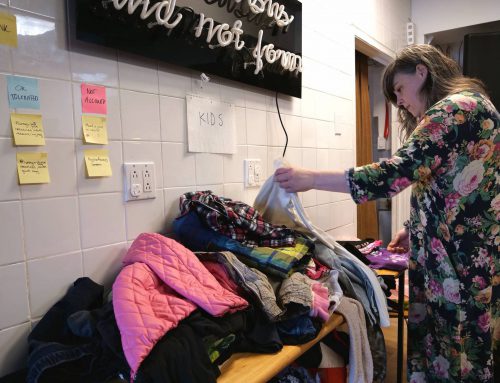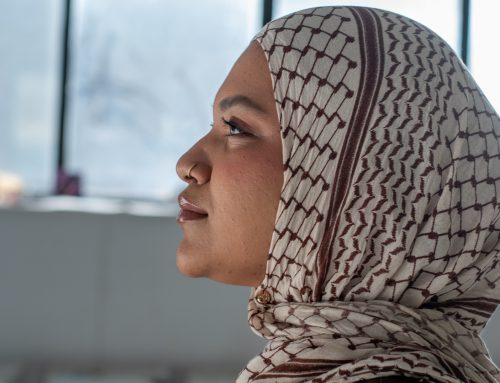BY Dylan Bossinakis-Clark & Fern Clair
Sarah Smith works for the Native Friendship Center in downtown Montreal. After experiencing worker burnout, she knows just how difficult the job can be.
“Burnout happens in every single community-oriented organization,” Smith said, explaining that she doesn’t know of any shelter, day center or any organization that provides frontline services to those experiencing homlessness that doesn’t experience worker burnout.
She says understaffing has become a huge problem in many homeless shelters, especially in recent years.
“This has been an ongoing issue. I mean, we’ve done so many recruiting blitzes, but it’s just a hard job in general. It’s not something that people tend to think about as a career option, so it takes a very specific kind of person, and I think that’s the case for every other homeless shelter.”
James Hughes, the president and CEO of Old Brewery Mission, says staffing has been a struggle.
“We’ve had challenges, as so many other organizations have, for many years,” he says. “The problem has been exacerbated with the onset of the pandemic, with the tightening labor market and due to the need of expanding our emergency services to meet the needs of the growing homeless population.”

Chez Doris is a women-only shelter in the downtown Montreal area. In 2021 Chez Doris opened up a fundraising campaign that helped raise money to increase their services such as an emergency night shelter.Chez Doris is located in Chomedy, Montreal and are open 24/7 to help shelter homeless women in the Montreal area. Photo by Dylan Bossinakis-Clark.
One major factor that has caused homeless shelters to experience worker burnout and understaffing is the ongoing COVID-19 pandemic. According to Smith, the pandemic has prevented many volunteers from helping out, putting more of a burden on staff.
“In general, it’s very frustrating. It’s already a hard enough job as it is, and now with all these restrictions that we have, it makes it even harder for us,” she says. “For example, we can only have 10 community members in the centre at all times. So, for sanitary reasons, we’re not accepting volunteers to help us with our day to day operations.”

Volunteers prepare snacks in the basement of Resilience Montreal, a shelter for the homeless population found in Cabot Square, Resilience has over 100 volunteers who are integral to the running of the shelter. Photo by Fern Clair.
Many shelters have been struggling to recruit new volunteers since the start of the pandemic. Hughes emphasizes the importance of hiring full-time workers to help the overworked staff members.
“What we have been needing are staff members. We’ve been campaigning intensively for the last number of months to recruit individuals with a background in counseling and intervention. We need people who are comfortable and ready to work with the homeless population.”

Resilience Montreal relies heavily on it’s volunteer’s to do things like cooking, serving, and cleaning. Allowing the staff to fully focus on their clients and ensure everything runs smoothly. Photo by Fern Clair.
With shelters struggling, Montreal is looking to the province for more help.
“Health and social services are responsibilities that fall under the Government of Quebec,” says city representative Guillaume Rivest. “It is up to the provincial government to put in place specialized human resources in the shelters in order to support people experiencing homelessness with dignity.”
Rivest claims that the municipal government is determined to aid the provincial government in solving the issue of understaffing.
“Montréal is acting as an ally by offering its full cooperation to the government of Quebec, the health network and community organizations to develop sustainable solutions that are open year-round in the metropolis.”
The municipal government has budgeted more than $35,000 per homeless person on social housing and to help the homeless population in Montreal this year. However, that’s lower than other major Canadian cities like Vancouver ($115,000) and Edmonton ($98,000).
A bar graph measuring the amount spent by Canadian cities on homelessness per capita. Montreal is ranked 4th out of the 9 Canadian cities listed. Made by Dylan Bossinakis-Clark.
Hughes says Montreal has been very supportive of the Old Brewery Mission and other homeless shelters struggling with understaffing.
“The municipal government has been very proactive in helping us identify facilities to be able to support homeless people, especially during the winter time.”
That support included the opening of warming stations during Winter months in recent years. “They’ve never done that before as far as I know,” Hughes says. “That was at their own cost and their own facility, staffed by their own people.”

The warming shelter Indigenous Support Workers Project found in Plateau Mont-Royal. The shelter is open to the homeless Inuit population who live in the Plateau area. Photo by Dylan Bossinakis-Clark.
Actions are being taken to help homeless shelter workers. The number of volunteer organizations have started to increase. These organizations were created as a way to lend a hand to homeless shelters workers who are understaffed and feeling burnout.
Mobilizing Milton Parc is a volunteer run organization that has stepped up during the pandemic to support homeless shelters and advocacy organizations, they donate food, items such as phones and clothes. Video by Fern Clair.
“We do have some volunteers mainly for the food security program,” says Hughes. “We offer a lot of programs and services. The food security program we have gets volunteers to help with delivering food baskets, and to hand out the food that’s in the centre.”
In an effort to fight the issue of understaffing in homeless shelters, Smith calls on the government to take initiative and find a better way to support workers that are feeling burnout due to stress and understaffing.
“For years, we’ve been telling you what our needs are, we need to be able to train more people. To do this kind of work. We need to have more mental health resources that are in-person instead of being online. We need staff for work in the shelters.”




